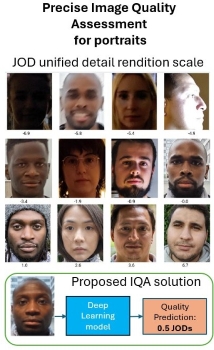
Portraits are one of the most common use cases in photography, especially in smartphone photography. However, evaluating portrait quality in real portraits is costly and difficult to reproduce. We propose a new method to evaluate a large range of detail preservation rendering on real portrait images. Our approach is based on 1) annotating a set of portrait images grouped by semantic content using pairwise comparison 2) taking advantage of the fact that we are focusing on portraits, using cross-content annotations to align the quality scales 3) training a machine learning model on the global quality scale. On top of providing a fine-grained wide range detail preservation quality output, numerical experiments show that the proposed method correlates highly with the perceptual evaluation of image quality experts.

Portraits are one of the most common use cases in photography, especially in smartphone photography. However, evaluating portrait quality in real portraits is costly, inconvenient, and difficult to reproduce. We propose a new method to evaluate a large range of detail preservation renditions on realistic mannequins. This laboratory setup can cover all commercial cameras from videoconference to high-end DSLRs. Our method is based on 1) the training of a machine learning method on a perceptual scale target 2) the usage of two different regions of interest per mannequin depending on the quality of the input portrait image 3) the merge of the two quality scales to produce the final wide range scale. On top of providing a fine-grained wide range detail preservation quality output, numerical experiments show that the proposed method is robust to noise and sharpening, unlike other commonly used methods such as the texture acutance on the Dead Leaves chart.